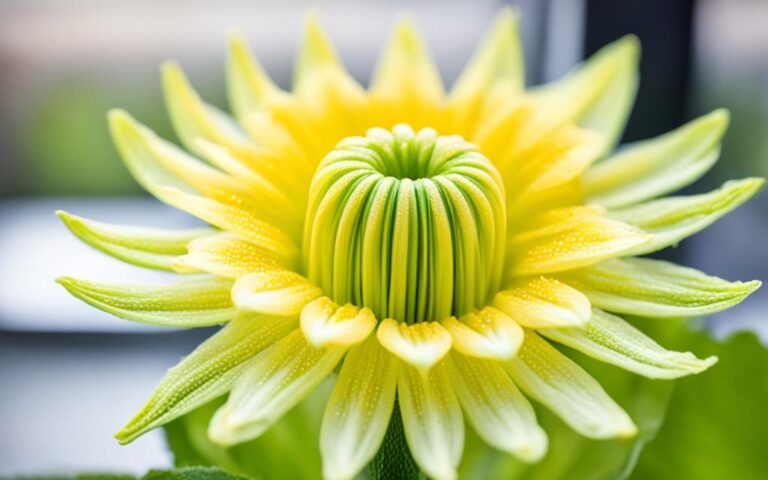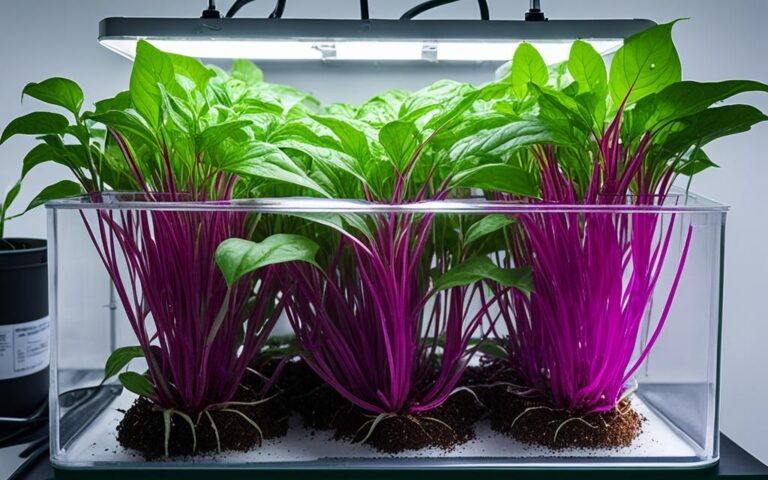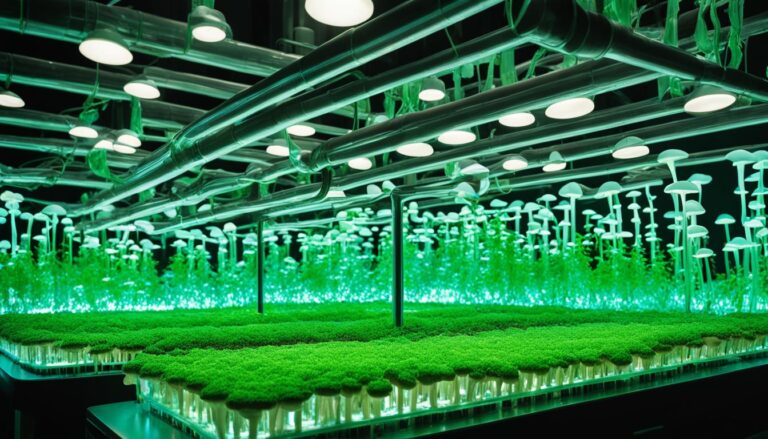Grow Hydroponic Lemon Balm at Home – Easy Guide
Do you want to try hydroponic gardening? Starting with hydroponic Lemon Balm is a great choice. This plant belongs to the mint family and is known for its lovely lemon and mint smell. It thrives well in a hydroponic system.
This guide makes it easy to grow Lemon Balm using hydroponics. You can have fresh herbs throughout the year. It takes just 4-6 weeks for them to grow. They need 14-16 hours of light daily. The EC range should be between 1.0 to 1.6 and pH between 5.5 to 6.5. With these conditions, growing Lemon Balm hydroponically is simple and fulfilling.
Key Takeaways
- Lemon Balm is part of the mint family, known for its lemon and mint scent.
- Learning how to grow hydroponic Lemon Balm offers fresh herbs year-round.
- Optimal growth occurs with 14-16 hours of light exposure per day.
- The ideal EC range for Lemon Balm hydroponics is 1.0 to 1.6.
- Maintain a pH range of 5.5 to 6.5 for best results.
Table of Contents
Introduction to Hydroponic Lemon Balm
Hydroponic gardening is a modern way to grow plants, and Lemon Balm (Melissa officinalis) thrives with this method. By using a hydroponic Lemon Balm setup, you bypass soil issues. This way, your Lemon Balm plant hydroponic grows faster and healthier.
Hydroponically growing lemon balm hydroponically gives you total control over its environment. You ensure the roots get exactly what they need. This means plants grow stronger and more lush.
In hydroponics, it’s easy to keep nutrients, water, and pH levels just right. Keeping these factors balanced boosts your Lemon Balm plant hydroponic‘s growth. You end up with aromatic leaves that are perfect for cooking and healing.
Benefits of Growing Lemon Balm Hydroponically
Exploring the benefits of hydroponic Lemon Balm shows many nutritional and aromatic perks. Plus, it’s great for cooking. Growing Lemon Balm this way brings better growth and more yields. This makes it a top pick for home growers and commercial farms.

Nutritional Benefits
Lemon Balm grown hydroponically is packed with antioxidants, vitamins, and minerals. It’s especially rich in Vitamin C and Thiamin, boosting overall health. The controlled hydroponic environment helps grow healthier plants. These plants have better nutrition compared to others.
Aromatic and Culinary Uses
Lemon Balm’s smell makes it perfect for many foods. Growing it hydroponically means you always have fresh leaves for your kitchen. You can use it to add flavor to teas, salads, sorbets, and more. This ensures enjoyable cooking and eating.
| Benefits | Description |
|---|---|
| Nutritional Value | High in antioxidants, Vitamin C, and Thiamin |
| Aromatic Quality | Strong, pleasant fragrance ideal for culinary uses |
| Controlled Environment | Healthy plants with optimal nutrient uptake |
| Consistent Supply | Steady production of fresh Lemon Balm leaves year-round |
Best Lemon Balm Varieties for Hydroponics
Growing Lemon Balm hydroponically brings many benefits like stronger flavors and bigger harvests. It’s key to know the best hydroponic Lemon Balm varieties for your needs. Different types are best for aromas or cooking.
Lemon Balm enthusiasts love Citronella for its power to keep mosquitoes away. It’s great for cooking and being outside. Also, Variegated Lemon Balm is loved for its lemon and mint taste. It’s perfect for food and aromatherapy.
For a great scent, Limonella is a top choice. Its smell is stronger in hydroponics than in soil. Lime Balm is also amazing with its strong lime scent. It makes drinks and salads exciting.
Here’s a summary of these top Lemon Balm choices for hydroponics:
| Variety | Key Features |
|---|---|
| Citronella | Mosquito repellent properties |
| Variegated | Combination of lemon and mint flavors; popular in cooking and aromatherapy |
| Limonella | High fragrance, excellent for aromatic use |
| Lime Balm | Strong lime scent, perfect for culinary enhancements |
Picking the best like Citronella, Variegated, Limonella, and Lime Balm enhances your hydroponic garden. You get better taste and use from your plants.
Starting Lemon Balm: Seeds vs. Transplants
When you think of starting hydroponic Lemon Balm, there’s a choice to make. Do you use seeds or transplants? Both offer different benefits depending on your goals and resources.
Advantages of Seeds
Choosing seeds for hydroponic Lemon Balm can save you money and offer more variety. You can try various types of Lemon Balm which might not come as transplants. Seeds usually sprout in 7-10 days, letting you see progress quickly.
- Cost-effectiveness: Seeds are generally cheaper than buying transplants.
- Variety: Access to a wider selection of Lemon Balm types.
- Control: Start from scratch and manage every growth phase.
Benefits of Transplants
Going for Lemon Balm hydroponic seedlings speeds up the process. Transplants help you grow plants faster and reduce the wait time for harvest. They’re especially good for beginners or those eager to see results fast.
- Head Start: An advanced stage of growth when compared to seeds.
- Time-Saving: Reduced waiting period for harvesting.
- Ease: Simplifies the initial stages of growing Lemon Balm hydroponically.

The choice between seeds and Lemon Balm hydroponic seedlings depends on your personal needs, goals, and resources. Here’s a table to help you compare:
| Hydroponic Lemon Balm Seeds | Lemon Balm Hydroponic Seedlings | |
|---|---|---|
| Cost | Lower | Higher |
| Variety | Wider | Narrower |
| Growth Time | Longer | Shorter |
| Ease of Use | Moderate | Easy |
Choosing the Right Hydroponic System
Choosing the best hydroponic system for Lemon Balm is important. Each method has its own pros and is suited for different skill levels and needs. We will look at three popular systems to grow Lemon Balm in the best way possible.
Deep Water Culture
The Deep Water Culture (DWC) system is simple and great for starters. Lemon Balm roots soak in a nutrient-packed solution, getting all the water and food they need. This helps them grow fast and is why many think it’s the top choice for Lemon Balm.
Nutrient Film Technique
The Nutrient Film Technique (NFT) is another top pick for Lemon Balm. It gently covers the roots with a stream of nutrient-rich water. This setup supplies steady nutrients and air, boosting plant growth. It’s a smart pick for detailed nutrient control.
Wick Systems
Wick Systems are ideal for hydroponics newbies. A wick pulls the nutrient mixture into the growth area. It’s simple, needs few supplies, and is easy to handle. This method works great for small Lemon Balm gardens and for those just starting.
To sum up the options:
| Hydroponic System | Key Features | Ideal For |
|---|---|---|
| Deep Water Culture | Constant nutrient access, rapid growth | Beginners, efficiency seekers |
| Nutrient Film Technique | Continuous nutrient and oxygen flow | Controlled environment lovers |
| Wick Systems | Low maintenance, passive nutrient delivery | Beginners, small-scale growers |
Setting Up Your Hydroponic Lemon Balm System
Starting a hydroponic Lemon Balm system is thrilling. It gives you lush, aromatic crops all year. First, pick a spot in your home that has good air flow. Make sure it’s big enough for your system.
Then, select the right hydroponic setup for herbs. You might like Deep Water Culture (DWC) or Nutrient Film Technique (NFT). Your system should keep the water and nutrients flowing well for healthy plants.
For lighting, choose high-quality grow lights that act like the sun. LED lights work well and cover all light needed for strong growth. Make sure the lights spread evenly over your plants.
The type of growing medium is also very important. Hydroton (clay pebbles), Rockwool, and coco coir are great. They support roots, let air in, and help with nutrient use.
Last, mix a balanced nutrient solution just for herbs. Check and keep the pH levels between 5.5 and 6.5. Keeping the pH and nutrients right will help your plants grow strong and yield a lot.
| Setup Component | Recommendations |
|---|---|
| Space Selection | Well-ventilated, sufficient room for system |
| Hydroponic System | DWC, NFT, or other suitable options |
| Lighting | LED grow lights, evenly positioned |
| Growing Medium | Hydroton, Rockwool, coco coir |
| Nutrient Solution | Tailored for herbs, pH 5.5-6.5 |
Nutrient Management and pH Levels
To grow hydroponic lemon balm successfully, pay attention to nutrient management and pH levels. It’s crucial to use a balanced nutrient mix and keep the pH just right. This is key for your plants’ health and growth.
Essential Nutrients Required
Hydroponic Lemon Balm needs a mix of important nutrients to grow well. It uses big amounts of nitrogen, phosphorus, and potassium. Calcium, magnesium, and iron are also necessary. Getting the right mix is important for the plants’ leaves to be healthy.
Keep an eye on the nutrient levels and refresh them regularly. This ensures your plants get what they need to flourish.
Maintaining the Optimal pH Range
For hydroponic Lemon Balm, the pH is really important. A pH between 5.5 and 6.5 is best. This lets the plants use the nutrients properly.
Test the pH often and adjust if needed. This helps avoid problems and keeps your lemon balm healthy. Professional hydroponic systems offer tools to check and adjust pH easily.
Lighting and Temperature Requirements
Getting the right lighting and temperature is key for growing Lemon Balm in hydroponic systems. The right grow lights and the correct temperature help the plants grow healthy and give a good yield.
Types of Grow Lights
There are different Lemon Balm grow lights, each offering special benefits. The popular choices include:
- LED Grow Lights: They save energy and last a long time. They offer the light needed for all phases of growth.
- T5 Fluorescent Grow Lights: Best for small spaces. They are intense and cover a large area.
- High-Intensity Discharge (HID) Lights: Great for big setups. They provide lots of light.
For the best results, keep grow lights on Lemon Balm for 14-16 hours every day. Change the light’s duration and strength based on the plant’s stage. This will make your plants healthier and more productive.
Optimal Temperature Ranges
Keeping the right temperature is just as important. Lemon Balm likes it cooler, between 60-70°F (15-21°C). This keeps the plants from getting too hot, which can make them bolt or taste bitter.

Watch and adjust the temperature along with the grow lights. This balance is crucial for strong growth in your hydroponic garden.
Watering Schedule for Hydroponic Lemon Balm
For hydroponic Lemon Balm care, setting up the right watering schedule is key. It stops both over-watering and under-watering. This ensures your plants grow strong and healthy.
Keeping your hydroponic Lemon Balm properly watered is critical. A Ceramic Self Watering Planter is a great option. It keeps the moisture just right, avoiding too much water.
To get your watering schedule for hydroponic Lemon Balm right, follow these steps:
- Check the roots often to make sure they’re not sitting in water too long.
- Change how often you water based on the weather and how humid it is.
- Make sure the water is fresh and has plenty of oxygen to stop root disease.
Having a consistent watering routine is crucial for healthy hydroponic Lemon Balm. With the right tools and careful attention, managing Lemon Balm hydroponic watering becomes easier. This helps your plants grow better.
Common Pests and Diseases
In hydroponic Lemon Balm farming, it’s crucial to manage pests and diseases well. This keeps the plants healthy.
Identifying Pests
Aphids and spider mites are common pests in hydroponic Lemon Balm. These small bugs can do a lot of harm if not caught early. Aphids look like tiny green insects on new growth. Spider mites are little red or brown dots on leaves.
Treatment and Prevention
Good disease management for Lemon Balm includes watching your plants closely and acting fast.
For dealing with pests:
- Get rid of sick leaves and throw them away the right way.
- For small problems, use soap for bugs or neem oil.
- Add ladybugs to help control the aphids.
To prevent pest problems in your hydroponic herbs:
- Keep your growing area clean by sanitizing your equipment often.
- Make sure there’s good air flow to stop pests from multiplying.
- Check your plants often for early signs of trouble.
Pruning and Harvesting Your Lemon Balm
It’s crucial to know how to prune and harvest Lemon Balm in a hydroponic system. These steps keep your plant healthy and increase its output. Your Lemon Balm will stay bushy and produce a lot throughout its life.
Tips for Pruning
Pruning your Lemon Balm in hydroponics makes it grow more leaves. Cut the top leaves to help the plant branch out. This makes your Lemon Balm look better and gives you more to harvest later.
“Pruning is a gardener’s best friend when it comes to keeping Lemon Balm productive and thriving in a hydroponic system.”
Harvesting Techniques
Harvesting Lemon Balm in a hydroponic system needs care. Cut stems carefully, taking no more than one-third of the plant. This technique helps your plant keep growing and ensures a steady supply of herbs.
| Method | Details |
|---|---|
| Pruning | Trim tops and encourage bushier growth, removing any yellow or damaged leaves. |
| Harvesting | Cut stems just above a leaf node and avoid taking more than one-third of the plant. |
Maximizing Your Hydroponic Lemon Balm Yield
To get the most out of your hydroponic Lemon Balm, a perfect growing setting is key. This means the right amount of light, the best temperature, and the proper nutrients. By keeping a close eye and making necessary tweaks, you’ll see a notable rise in both the quantity and quality of your Lemon Balm.
- Lighting: Ensure enough steady light with top-notch grow lights.
- Temperature: Keep it between 65-85°F for the best growth.
- Nutrients: Choose a nutrient mix that suits Lemon Balm perfectly.
Pruning and harvesting right can also boost your Lemon Balm harvest. Trim regularly to get bushier plants and prevent thin stems. Also, picking Lemon Balm at the right time keeps it producing more.
Check out this table for the best ways to improve your Lemon Balm hydroponics:
| Aspect | Description | Impact |
|---|---|---|
| Lighting | Consistent and sufficient | Boosts photosynthesis, essential for growth |
| Temperature | Optimal range of 65-85°F | Prevents heat stress and encourages healthy development |
| Nutrient Solution | Balanced mix specific to Lemon Balm | Ensures plants receive necessary macro and micronutrients |
| Pruning | Regular trimming of stems | Promotes bushier growth and higher yield |
| Harvesting | Timely and consistent | Stimulates further production |
Following these steps will help you maximize your hydroponic Lemon Balm yield. Enjoy your abundant harvest throughout the year.
Hydroponic Lemon Balm: Troubleshooting Tips
Keeping your hydroponic Lemon Balm healthy needs careful watching and solving problems on time. This part shares key tips to tackle usual Lemon Balm hydroponic challenges.
Diagnosing Common Issues
Lots of problems can pop up when you grow Lemon Balm hydroponically. You might face nutrient shortages, pH levels off balance, pest troubles, or not enough light. Figuring these out early is key to managing them well.
- Nutrient Deficiencies: Yellow leaves or short growth show missing vital nutrients.
- pH Imbalances: pH outside 5.5 to 6.5 can block nutrients, causing trouble for your Lemon Balm.
- Pest Infestations: Watch for aphids, whiteflies, or spider mites on your plants.
- Inadequate Lighting: Weak or tall stems could mean not enough light.
Corrective Actions
To fix these Lemon Balm hydroponic issues, here are steps to take:
- Adjust Nutrient Solutions: Use balanced nutrients. Look at a Lemon Balm nutrient guide if needed.
- pH Adjustment: Use solutions to keep pH between 5.5 and 6.5 for the best nutrient use.
- Pest Control: Use safe pesticides or natural predators, like ladybugs, for pests.
- Improve Lighting: Make sure your Lemon Balm gets 14-16 hours of light every day.
With these steps, you can keep your Lemon Balm hydroponic system healthy. Then, you can look forward to a great Lemon Balm harvest.
Conclusion
Starting to grow hydroponic Lemon Balm at home is rewarding and useful. This guide showed you key steps, from picking the right varieties to controlling nutrients and pests. Follow these tips to keep your Lemon Balm healthy and get lots of it.
Hydroponic Lemon Balm brings many benefits. It lets you grow fresh herbs all year. Plus, it helps you get the most out of Lemon Balm’s smell and taste. Whether you want it for tea, cooking, or health, hydroponics is a dependable way to grow it.
This guide aimed to give you good advice and tips for growing hydroponic herbs. Keep caring for your plants and improving your gardening skills. Growing Lemon Balm this way is not only fun but also teaches you about eco-friendly gardening.






